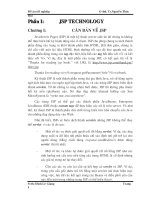technologies document wifi technology
Bạn đang xem bản rút gọn của tài liệu. Xem và tải ngay bản đầy đủ của tài liệu tại đây (1.74 MB, 21 trang )
<span class="text_page_counter">Trang 1</span><div class="page_container" data-page="1">
Nguyen Hoang Son Bui Anh Chien Nguyen Tan Canh
<b>Approved byProject - Mentor:</b>
Name: Le Van Tinh Signature Date
</div><span class="text_page_counter">Trang 2</span><div class="page_container" data-page="2"><b>PROJECT INFORMATION</b>
<b> PROJECT INFORMATION</b><b>Project </b>
<b>Acronym</b> <sup>Wi-Fi</sup>
<b>Project Title</b> Introduction to Wifi
<b>Start Date</b> 17 - Sep - 2023
<b>End Date:</b> 27 - Nov - 2023
<b>Lead Institution International School, Duy Tan UniversityProject Mentor</b> MSc. Tinh, Le Van
<b>Scrum Master</b> Son, Nguyen Hoang <sup></sup> om
<b>Team Members</b>
Chien, Bui Anh
Canh, Nguyen tan
</div><span class="text_page_counter">Trang 5</span><div class="page_container" data-page="5"><b>4. AD HOC AND INFRASTRUCTURE MODES:...9</b>
<b>1. INTRODUCTION OF WIFI TECHNOLOGY1.1. Definition:</b>
Wi-Fi is a wireless technology used to connect electronic devices, such as computers, mobile phones, tablets, and smart devices, to the internet or to other devices. without using cables. The name "Wi-Fi" stands for "Wireless
</div><span class="text_page_counter">Trang 6</span><div class="page_container" data-page="6">Fidelity", and it refers to the technical standards that devices use to transmit data wirelessly via radio waves.
Wi-Fi devices send and receive data via radio waves at different frequencies, the most common being 2.4 GHz and 5 GHz. Wi-Fi is commonly used in home, business, and public environments, helping users access the internet and share network resources without needing a direct cable connection. Popular Wi-Fi standards include IEEE 802.11a, 802.11b, 802.11g, 802.11n, 802.11ac, and 802.11ax, each with different
characteristics and data transfer speeds.
<b>1.2. History of formation:</b>
The first research into using radio waves to transmit data wirelessly began in the 1970s.
During the 1980s, the National Institute of Standards and Technology (NIST) promoted research and development of wireless standards.
In 1997, IEEE (Institute of Electrical and Electronics Engineers) established a working group to develop standards for wireless data transmission, leading to the birth of the 802.11 standard.
<b>2.PRINCIPLE OF OPERATION2.1.Radio wave:</b>
Wifi uses radio waves to transmit data between wireless devices and the base station (access point). These radio waves operate at certain frequencies, such as 2.4 GHz or 5 GHz.
</div><span class="text_page_counter">Trang 7</span><div class="page_container" data-page="7">Radio waves allow data to be transmitted over space without using cables, increasing the flexibility and utility of wifi.
<b>2.2. Half Duplex Mechanism:</b>
In a half duplex communication environment, a device can transmit data or receive data at a particular time, but cannot do both simultaneously.
In wifi, when a device sends data, it cannot listen to data simultaneously from other devices. The half duplex principle helps avoid data conflicts when multiple devices try to communicate simultaneously.
<b>2.3. CSMA/CA</b>
(Carrier Sense Multiple Access with Collision Avoidance):CSMA/CA is a mechanism for controlling communication access in wireless environments. It helps avoid data conflicts by checking the channel status before starting the data transmission.
The principle is that before sending data, the device will "listen" (carrier sense) to see if there is any data transmission signal on the channel. If the channel is in use, the device waits until the channel becomes free.
The device then sends a "Ready to Send" (RTS) signal to notify it of its intention to transmit data. If there is no conflict, the device will begin transmitting data. If there is a conflict, it will retry after a random amount of time to avoid repeated conflicts.
</div><span class="text_page_counter">Trang 8</span><div class="page_container" data-page="8"><b>3.CHANNEL AND FREQUENCY BAND3.1. 2.4 GHz:</b>
<b>3.2 5GHz:</b>
<b>3.3 . What is dual-band Wi-Fi?</b>
Basically, dual-band Wi-Fi is a Wi-Fi router that supports both 2.4GHz and 5GHz bands.
There are 2 types of dual band:
- Selectable dual-band: Two frequency bands 2.4GHz and 5GHz and only one of them can be transmitted.
- Simultaneous dual-band: Broadcast both 2.4GHz and 5GHz bands simultaneously.
</div><span class="text_page_counter">Trang 9</span><div class="page_container" data-page="9">There is also a tri-band Wi-Fi consisting of 2 5GHz bands and 1 2.4GHz band to serve many uses that require high speed.
<b>3.4. Comparison between 2.4GHz and 5GHz standards</b>
Under ideal conditions, the network speed of 5GHz WiFi can be up to 1300Mbps, a very impressive number compared to the 450-600Mbps speed of 2.4GHz WiFi. This means you can download files faster, open web pages faster, and play online games without worrying about network problems.
<b>Connection range</b>
According to a principle in radio wave transmission, the higher the frequency, the higher the signal attenuation over distance. Because 5GHz WiFi operates at a high frequency band, you won't get as wide a connection range as 2.4GHz WiFi.
<b>Interference ability</b>
No interference from other devices. With 2.4GHz WiFi, devices such as Bluetooth speakers, Bluetooth headsets, etc. use electromagnetic waves that can cause network interference, causing network speed to decrease. For
</div><span class="text_page_counter">Trang 10</span><div class="page_container" data-page="10">5GHz WiFi, you will be completely unaffected by wireless devices, giving you a more stable network speed.
<b>Congestion control:</b>
Because 5GHz WiFi operates at a wider frequency band than 2.4GHz WiFi, you won't have to worry about congestion when there are too many devices accessing the network, meaning you will always have a stable network connection, ensuring Your work is always smooth
<b>4. AD HOC AND INFRASTRUCTURE MODES:</b>
<b>4.1 AD Hoc:</b>
In ad hoc mode, Wi-Fi devices communicate directly with each other without the need for a central access point (AP) or network infrastructure.
Ad hoc networks are often created on-the-fly, allowing devices to connect and communicate with each other in a peer-to-peer fashion.
This mode is useful in situations where a network infrastructure is not available or practical, such as in temporary or ad hoc gatherings of devices.
</div><span class="text_page_counter">Trang 11</span><div class="page_container" data-page="11"><b>4.2. Infrastructure mode:</b>
In infrastructure mode, Wi-Fi devices communicate through a central access point (AP), which acts as a hub for coordinating communication between devices on the network.
The access point is usually connected to a wired network, such as an Ethernet network, and serves as a bridge between the wireless devices and the wired network.
Infrastructure mode is the more common mode for typical Wi-Fi networks, such as those found in homes, offices, and public spaces.
<b>6.WIFI NETWORK MODEL:</b>
6.1 SOHO:
</div><span class="text_page_counter">Trang 12</span><div class="page_container" data-page="12"><b>-Modem:Converts Internet signals from your service provider (ISP) into a </b>
form usable for your local network.
- Wireless router (AP): A router is capable of broadcasting Wi-Fi to allow wireless devices to connect.
- Wireless Network Interface Card (Wireless NIC or Wireless Adapter): A component in a computer or mobile device that allows connection to a Wi-Fi network
6.2 Enterprise:
- AP: In an enterprise environment, there may be multiple APs deployed to ensure sufficient coverage and capacity for users.
</div><span class="text_page_counter">Trang 13</span><div class="page_container" data-page="13">-Wireless Controller: Wireless Controller is a centralized management device that helps manage and configure Access Points in the network.
It provides centralized management, security policies, and performance monitoring of Wi-Fi networks.
-Authentication Server: Authentication Server performs the process of authenticating users when they try to connect to a Wi-Fi network. It is common to use protocols such as WPA2-Enterprise or 802.1X to
authenticate users.
- Potal Server: Portal Server works as an information portal and is often used to deploy login pages .
- Location-Based Service: Location-Based Service allows tracking and locating mobile devices in Wi-Fi networks. It can be used for management purposes and to provide location-based services.
-Wireless IPS: Wireless IPS helps protect Wi-Fi networks from intrusion attacks by monitoring and detecting suspicious activity.
-RRM: RRM is an automated feature that helps manage radio resources in a Wi-Fi network, including managing frequency, power, and other changes to optimize network performance.
<b>6. IEEE 802.11 STANDARDS:</b>
<b>•Generation 1 – Wi-Fi 802.11 standard:</b>
In 1997, IEEE (Institute of Electrical and Electronics Engineers) created the 802.11 standard as the first standard for WLAN. However, 802.11 only supports a maximum network bandwidth of up to 2Mbps - too slow for most applications. Today, products that comply with the 802.11 standard are no longer manufactured.
</div><span class="text_page_counter">Trang 14</span><div class="page_container" data-page="14"><b>•Generation 2 – 802.11b:</b>
Expanding on the 802.11 standard creates the 802.11b standard. The 802.11b standard uses the same unregulated radio frequency (2.4 GHz) as the original 802.11 standard. This standard supports bandwidth up to 11Mbps. At that time, vendors preferred to use 802.11b frequencies to reduce production costs.
<b>•Generation 3 – 802.11g Wi-Fi Standard </b>
In 2002 and 2003, WLAN products supported a newer standard, 802.11g. This was a highly appreciated standard on the market at that time. With the advantages of the 802.11a and 802.11b standards combined to create the 802.11g wireless network standard. It supports bandwidth up to 54Mbps and uses 2.4 Ghz frequency for wide range. And 802.11g is compatible with 802.11b standards.
<b>•Generation 4 – 802.11nStandard </b>
802.11n (short for Wireless N) is designed to improve upon 802.11g in total supported bandwidth by utilizing multiple wireless signals and antennas (MIMO technology ). The 802.11n standard provides a maximum bandwidth of up to 600 Mbps, better range than previous Wi-Fi standards due to its increased signal strength, and 802.11n is backward compatible with 802.11b and 802.11 devices. g. The 802.11n standard supports up to 4 concurrent streams. 802.11n uses multiple parallel wireless antennas to transmit and receive data. The related term MIMO (Multiple Input, Multiple Output) refers to the ability of 802.11n and similar technologies to coordinate multiple radio signals simultaneously. MIMO helps increase both the range and throughput of a wireless network. 802.11n devices operate in both the 2.4 GHz and 5 GHz bands.
<b>•Generation 5 – 802.11ac Wi-Fi standard:</b>
</div><span class="text_page_counter">Trang 15</span><div class="page_container" data-page="15">802.11ac is the most commonly used Wi-Fi standard today. 802.11ac uses dual-band wireless technology, supporting simultaneous connections on both the 2.4 GHz and 5 GHz bands. 802.11ac provides backward
compatibility with 802.11b, 802.11g, 802.11n standards and bandwidth up to 1,300 Mbps on the 5GHz band, 450 Mbps on 2.4GHz.
<b>•Generation 6 – Wi-Fi standard 802.11ax:</b>
Wi-Fi 802.11ax is the name of the latest 6th generation Wi-Fi wireless network standard (referred to as Wi-Fi 6). This generation has many strong improvements compared to generation 5. Wi-Fi 6 has been officially applied since 2019. Promising the ability to meet the needs of an increasingly developing "digital world". Extremely fast connection speed, reduced latency. The 802.11ax standard provides a speed of 9.6Gbps, an increase of 40% compared to generation 5 (6.9Gbps). Equipped with OFDMA technology, it almost completely eliminates waiting time when sending and receiving data. From there, reduce latency, improve speed, and experience more convenient use.
<b>-The technology used in 802.11 ax:1.OFDMA:</b>
OFDMA stands for Orthogonal Frequency Division Multiple Access -Orthogonal frequency division multiple access. OFDMA has the ability to divide a data transmission channel into smaller frequencies called "subcarriers".
A Wi-Fi 6 router that uses OFDMA will send multiple signals in the same data transmission session. This makes it possible for users to transmit data to multiple devices in parallel from one router's network connection.
On an OFDMA link, the router can use different groups of "subcarriers" to send packets to different clients, and latency can be
</div><span class="text_page_counter">Trang 16</span><div class="page_container" data-page="16">managed. This method of communication provides flexibility, increasing network speed and efficiency.
- Benefit:
+Serve more clients. + Lower latency + Good for low data rates + Good for small packets
<b>2. MU-MIMO</b>
Multi-user , multi-input, multi-output:
</div><span class="text_page_counter">Trang 17</span><div class="page_container" data-page="17"><b> What is MU-MIMO technology?</b>
MU-MIMO (short for Multi-User Multiple Input and Multiple Output) uses multiple antennas to transmit and receive signals of wireless
connections in Wi-Fi routers.
MU-MIMO technology has the ability to fully exploit the Wi-Fi broadcasting capabilities in broadcasting devices and help your device receive Wi-Fi waves more easily
<b> Operating principle of MU-MIMO:</b>
The Wi-Fi router will be equipped with 1 antenna for communication and 1 antenna placed on the receiving device. Wi-Fi waves will transmit and receive data packets through this antenna. Therefore, the more antennas you use to transmit and receive waves, the more stable the transmitted signal will be.
MU-MIMO technology brings many benefits such as:
Eliminates flickering and congested Wi-Fi problems to help you exchange data faster and without interruption.
</div><span class="text_page_counter">Trang 18</span><div class="page_container" data-page="18">Allows the router to handle Wi-Fi operations more powerfully, increasing the router's performance and capacity.
The router can divide individual data packets and send them to multiple devices at the same time.
Beamforming is a technology that helps focus Wi-Fi signals in a direction instead of spreading across an entire area.
For Wi-Fi Routers that apply Beamforming technology, the Wi-Fi signal will determine the location of the device using the Internet, thereby adjusting to a specific target, helping to reduce interference and minimize interference. signal optimization.
- Principle of operation:
Beamforming relies on antennas that use Wi-Fi MIMO technology to transmit and receive signals of a wireless connection. Data will be processed by broadcasting different signals at different antennas, helping the signal to be transmitted concentrated in a specific direction.
Benefits of Beamforming technology
- Beamforming technology has the following roles:
+ Optimizes Wi-Fi signal in a specific direction, helping the receiving device receive better signal transmission.
+ Stable Wi-Fi connection, helps you watch videos or make video calls in HD mode, without lag.
+ Better Wi-Fi connection quality, smoother Internet surfing. + Reduces signal interference by reducing unnecessary radio frequency interference.
<b>7.WIFI SERCURITY:</b>
</div><span class="text_page_counter">Trang 19</span><div class="page_container" data-page="19"><b>7.1 WEP (WIRED EQUIVALENT PRIVACY)</b>
<b>- WEP (Wired Equivalent Privacy)</b> is the first of <b>Wireless Security Protocols</b>. It has developed at 1999. It was developed to protect the wireless data
between <b>Clients</b> and <b>Access Points (APs)</b> towards <b>hackers</b>.
- At the beginning maximum 64-bit encryption was allowed in US. So, WEP was using <b>64-bit</b> encryption. After the restrictions, <b>128-bit</b> and <b>256-bit</b> WEP has developed.
- WEP was widely used but it has too vulnerable to the <b>password hacks</b>. Cybersecurity experts detect many vulnerabilities of this first Wireless Security Protocol.
<b>So, Wi-Fi Alliance retired it offically at 2004. For today’s World WEP (Wired Equivalent Privacy) is not a secure protocol and it is outdated.</b>
<b>7.2 WPA(WIFI PROTECTED ACCESS )</b>
- Wi-Fi Protected Access was developed at 2003 by WiFi Alliance. - With WPA , some additional sercurity mechanisms has developed. +“<b>Message Integrity Check</b>”:
The Message Integrity Check is a mechanism used to ensure the integrity of data transmitted over the wireless network. It provides a way to detect if the
</div><span class="text_page_counter">Trang 20</span><div class="page_container" data-page="20">data has been tampered with during transmission.
MIC helps protect against various attacks, such as packet alteration or injection, where an unauthorized party attempts to modify the content of the data packets.
<b>+ Temporal Key Integrity Protocol (TKIP):</b>
Temporal Key Generation: TKIP generates a new temporary key for each data packet transmitted. This is different from WEP, where a static key is used for all packets.
Initialization Vector (IV) Change: Each temporary key is associated with an initialization vector (IV). IV changes with each data packet, increasing system dynamism and security.
<b>7.3 WPA2 ( WIFI PROTECTED ACCESS 2)</b>
- WPA2 has developed at 2006 - AES ( Advanced Encryption Standard)
- CCMP (Counter Cipher Mode with Block Chaining Message Authentication code Protocol).
- WPA2-PSK & WPA2-Enterprise.
<b>7.4 WPA3 (WIFI PROTECTED ACCESS 3):Protection against Brute-Force attacks:</b>
When connecting to a secure Wi-Fi network using encryption, the client and access point perform a 4-way handshake. WPA3 uses the Simultaneous Authentication of Equals (SAE) protocol to protect the connection process, preventing attacks on your wireless connection even if your password is not strong enough.
<b>Advanced Corporate Security:</b>
WPA3 increases the key security level from 128-bit of WPA2-Enterprise to 192-bit. Meeting Commercial National Security Algorithm (CNSA)
</div>








